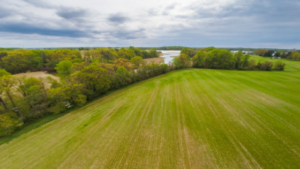The domino effect of climate change, impacts on farmland, and our ability to improve water quality in the Gulf

With both the gulf hypoxia report and the IPCC’s “Climate Change and Land” report just out, it’s daunting to think about what we farmers and conservationists are up against: a large dead zone in the Gulf of Mexico worsened by runoff from farmland, cities, and suburbs. Plus, the farming activity was stymied this spring by unprecedented rainfall and floods, further intensified by climate change.
As a farmer and a representative of a non-profit organization, I do not normally opine on climate change, we don’t speak about it that way in the Midwest, we speak about extreme weather. But the key findings of these two reports are linked.
First, what happens on the land drives the size and severity of the hypoxic zone. We know that and that’s one of the reasons AFT does the work we do in the Midwest, working at multiple scales such as with farmers in their fields individually and collectively in watershed-wideprojects, in the state legislature advocating for better crop insurance policy, and with USDA and Congress advocating for better federal policies and programs. We work to see more farmers adopt soil health practices like no-till or strip-till, cover crops, nutrient management, and conservation crop rotation. These practices offer a triple return because healthier soils improvefarmer productivity and profitability, reduce water pollution, and increase climate resiliency.
The IPCC tells us our ‘land is under pressure and land is part of the solution, with agriculture playing a key role.’ It says that in addition to human activity, climate change is degrading conditions on the land making it more challenging to help the soil do what it needs to do for our environment and the survival of our society. Luckily, the same soil health practices that improve farmland’s ability to withstand the negative impacts of climate change also result in better water quality for local streams, lakes, and the Gulf of Mexico.
Farmers can apply these practices by implementing a Conservation Cropping Systems, which increases nutrient efficiency and farm profitability, reduces sediment and nutrient losses, and makes farms more resilient to extreme weather conditions.
AFT supports the broader implementation of Conservation Cropping Systems by:
- Quantifying the economic benefits soil health practices
- Encouraging non-operating landowners, especially the growing percentage of women landowners, to engage with their farmers about adopting these win-win conservation practices
- Working with farmers in Illinois’ Upper Macoupin Creek Watershed, Vermilion Headwaters Watershed, and the Upper Scotio Watershed in Ohio
- Developing and testing strategies, in partnership with AFT’s national water initiative, that could help improve farming conditions across the Midwest and reduce fertilizer and soil loss that is causing the hypoxic zone in the Gulf of Mexico
We can tell you from our work on farms with farmers that extreme weather likely driven by climate change is making it tougher to deliver the much-needed progress in reducing nutrient and sediment runoff to the Gulf. This year, ground conditions got worse faster than improvements by farmers could be implemented, meaning more runoff than normal. So,despite farmers stepping up, the wet spring made it more difficult to manage key practices like cover crops.
There’s more, farmers are living through an extremely challenging time. You only need to read the news to know, trade wars and a slump in commodity prices and of course catastrophic flooding are making the economics of farming difficult. Meanwhile we are calling on them to do more on our behalf — solve the climate crisis, reduce runoff to improve local water quality and reduce the Gulf Hypoxia Zone. All fair asks, but not without economic impacts. When you are already operating on a thin margin and spending more could mean ruin or compromises at the family dinner table, it’s a tough decision.
So, what’s the bottom line; well, it’s the bottom line. We know that soil health practices provide positive economic benefits to farmers, as presented in our case studies featuring four “soil health successful” farmers. Farmers need a leg up — we need to put policies and programs in place that reimburse farmers for eco-services that benefit society as a whole.
Incentives will jump-start adoption.
Illinois’ new “Fall Covers for Spring Savings” program is an important example. Modeled after a similar program in Iowa, farmers who plant cover crops this fall can apply for a $5 per acre reduction in their crop insurance premium. These unique reward programs signal that cover crops are not risky; they are in fact a risk reduction practice. Seeing this into law in more states is imperative and already being discussed in Minnesota, Wisconsin, and Ohio.
Longer-term, the Farm Bill conservation title, despite becoming much more robust in the 2018 bill, will need to do more and create more synergy between conservation programs and crop insurance (risk management).
And, ultimately, we will need to create a marketplace for eco-services on farmland and ranchland to make them economically viable and to achieve the broadest possible implementation of conservation on farmland — conservation that fights climate change, improves resilience to it, and protects our important environmental resources like the Gulf.

